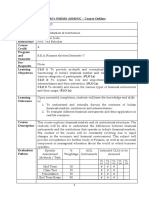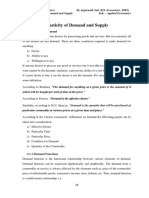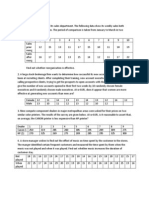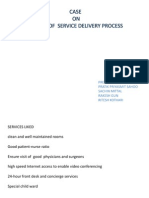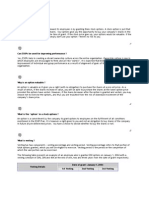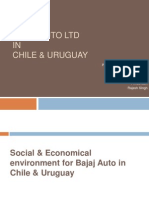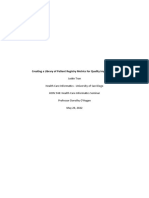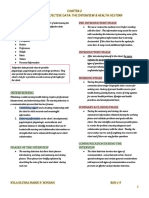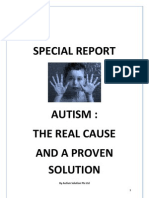Economics Cases
Economics Cases
Uploaded by
pramit04Copyright:
Available Formats
Economics Cases
Economics Cases
Uploaded by
pramit04Original Description:
Copyright
Available Formats
Share this document
Did you find this document useful?
Is this content inappropriate?
Copyright:
Available Formats
Economics Cases
Economics Cases
Uploaded by
pramit04Copyright:
Available Formats
CASE 1 What will happen to the price of milk?
As always, the movement in milk price in India is determined by the quantity of milk supply in the market and by the consumers willingness to buy milk. Short run seasonal factors and long run decisions on the number and quality of herd size influences the milk supply. At present the Indian economy being in recession, consumer incomes are low and therefore low demand and market prices of milk. Supply of milk in the market is fairly predictable. During summer less milk is available for marketing .while during winters greater quantity of milk is marketed. So the milk prices rise in the summers and fall in the winter years. The reason for such variation in supply is mainly biological in nature. Some studies on milk production in India have revealed that the seasonal variation in milk supply is also accompanied by significant economic milk cycle of a period of 15-26 years. The economic milk cycle is a result of over- reaction of the milk suppliers to both the upward and downward price signals. At present, the Indian milk market is experiencing low supplies, high seasonal price but is on the rising side of latest economic milk cycle. Demand for milk has been found to be influenced mainly by the retail prices of the milk, consumer tastes and the personal disposable income of the consumers. Low demand of the milk in the India is attributed mainly to the shift in consumers taste (both in the urban and rural sectors) and depressed consumers incomes due to recession during 1997-1983. Now the economic indicators are suggesting an economic recovery. It is, therefore, expected that the milk prices will rise, which should serve as signal for milk producers to augment their production capacity. It is expected that a 5% increase in consumers disposable income results in 2% increase for the demand for milk. In order to understand the effects of current recovery it is suggested to estimate and compare milk prices under two alternatives conditions: (1) economic recovery during the current period, (2) zero economic growth i.e., continued recession. After a statistical analysis of the data, it was found that the personal disposable income of the consumers is likely to increase at the most at 3% rate. While in case of the second alternative it was assumed that the consumer expenditure would remain at the same level as last year. Forecast of monthly supplies of milk was arrived at for both the alternatives. It was estimated that the milk prices have gradually increased due to economic recovery and are 4 to 6 percent higher than if recession had continued. It is expected that as recovery picks up, the milk prices would further improve and are likely to go up further by around 10% during the current month next year. It is therefore expected that the anticipated income recovery will strength the market for milk producers in the country. Questions: 1) What are the various determinants of demand for milk 2) How far the milk prices affected by (a) seasonal factors, (b) cyclical factors, and (c) other factors? 3) What is the measure of income elasticity of demand for retail price of milk?
CASE 2 Resolving Chinas Power Shortage Shanghai is Chinas financial and business hub. In late July 2004, with daytime temperatures reaching 37 degrees Celsius, the citys electricity consumption surged to a weekly record of 14.35 million kilowatt hours. The city authorities resorted to asking 2,100 businesses to operate at night, and a further 3,000 others to adjust operating hours. Even high-profile multinational companies were not spared. General Motors and Volkswagen were ordered to suspend production for more than a week each. Shanghai Volkswagen spokesman Lu Jun explained, It's a rule. We have to cut power for 10 days Weve cut power and so have had to stop production. It's all over Shanghai. The Shanghai episode mirrored a nationwide shortage of electric power. In Beijing, on July 22, 2004, the Municipal Power Supply Bureau imposed the capitals first brownout of the year, disrupting supply to suburban areas for 47 minutes in the afternoon. The Chinese government has certainly been working tirelessly to resolve the power crisis. Thermal coal is the principal fuel used to generate electric power in China. In July, Premier Wen Jiabao exhorted, Railway departments should do their utmost for the transport of coal for electricity generation.2 The Ministry of airways increased train speed and freight loads, and allocated 90% of freight capacity to transport key materials. In the first half of 2004, Chinese railways shipped 480 million tons of coal, up 12.2% over the same period last year. The Ministry of Communications has also pitched in. It diverted ships from overseas routes to domestic coal transport and approved emergency coal transportation on various roads and waterways. China is the worlds second-biggest coal exporter. In 2003, China exported 93 million tons of coal, including 80.8 million tons of thermal coal. To assure supplies to the electric power industry, the Chinese government has limited coal exports to 80 million tons in 2004. China Coal Import & Export Vice President Zhou Dongzhou predicted that exports of thermal coal would fall to 70 million tons. Since the 1960s, the Chinese government has regulated the supply of thermal coal to electric power plants. It requires coal mines to supply power plants with about one-quarter of coal purchases at a contract price. The government regulates the supply of coal to support its regulation of the electricity industry. In the late 1990s, the Chinese government dissolved the Ministry of Electric Power, and divided its functions between the State Electricity Regulatory Commission (SERC) and the State Power Corporation of China. The State Power Corporation owns five of the six transmission grids Northwest, North, Northeast, Central, and East) and about half of the national generating capacity. Regulation is necessary to ensure that the State Power Corporation does not abuse its monopoly power. The SERC regulates all aspects of the electricity industry, except pricing. With regard to electricity pricing, the SERCs role is to advise the National Development Reform Commission (NDRC). To ensure that electric power generation is economically viable, mines are required to sell coal cheaply to power plants. Typically, the government sets the price below the equilibrium market price. Many mines have ignored their contracts with power plants and sold coal on the higher market price to earn higher profits. Some power plants cut back production, so exacerbating the national power shortage. Some estimate that the nationwide power shortage will soon reach 30 million kilowatts, which is more than double Shanghais peak consumption. With China headed fo r a power crisis, the government is under pressure to increase electricity prices. In June 2004, following persistent rises in the cost of fuel, the NDRC increased electricity prices by an average of 2.2
fen per kilowatthour in the East, North, Central, and South grids. But, apparently, this increase has not been sufficient. The threat of a power crisis continues. Discussion Questions 1. Explain how the impact of a price increase on electricity consumption depends on the price elasticity of demand. 2. The price elasticity of the Indian demand for electricity has been estimated to be -0.65 among residential users and -0.45 among industrial users. If these elasticities apply to China as well, how will the impact of a price increase be spread between residential as compared with industrial users? 3. Many Chinese organizations ignore the market system. For instance, they borrow money from banks and refuse to repay, thus creating bad debts for lenders. Likewise, they might consume electricity without bothering to pay the power supplier. Do such organizations cause the demand for electricity to be more or less price elastic?
CASE 3 Case on Rent of Apartments Lets us take the case of a well-defined geographic area of a city. The area is composed exclusively of apartments and is populated by low-income residents. The people who live in the area tend to stay in that area because (1) they cannot afford to live in other areas of the city, (2) they prefer to live with people of their own ethnic group, or (3) there is discrimination against them in other areas of the city. Rents paid are a very high percent of peoples' incomes. (1) State whether the demand for apartments in this area be relatively inelastic or relatively elastic? Also state why. (2) What is the nature of the supply curve of apartments in this area and why (3) Show the equilibrium price and output. (4) Now assume the government creates a program. Under this program, the renter is required to pay 30% of income in rent. Any additional rent is paid by the government --- up to a limit. For example, a low-income person with an income of $1,000 a month would be required to pay $300 in rent (30%). If the rent is $500, the other $200 would be paid by the government. Analyze the results of this program. Show the changes on the graph and explain what will result. Who gains and who loses from this program? (5) Instead, now assume that the government decides to provide a subsidy to people who build apartments in this low-income area. A certain percent of their costs will be paid by the government. Analyze the results of this program. Show the results on the graph and explain what will result.
CASE 4 Case on Tobacco Policy in India India is the second largest tobacco leaf producing nation and the third largest tobacco consuming nation. On October 2, 2008, Indias national smoke-free law came into effect. Healthcare facilities, educational facilities and government facilities have been designated as smoke-free environments. However, the law allows for designated smoking rooms in hotels, bars, restaurants and airports. Enforcement and compliance levels vary by state and city. Tobacco advertising is banned in major media formats and there are restrictions on advertising at point of sale. However, size and advertising context restrictions at the point of sale are not enforced. Tobacco companies engage in surrogate advertising, e.g., by promoting fashion shows, award functions like bravery awards for women and so on. Health warnings have to be printed on packs of cigarettes. But WHO feels that the graphic images are weak and do not convey the harms of tobacco use. Health warnings have been found printed on the back of the pack instead of the front as required and are of smaller size than the required 40% of the front display area. All these policies are designed to affect the demand curve for tobacco products. We know that the Govt. can tax tobacco products to bring down consumption and that the incidence of taxation will depend on the relative price elasticitys of demand and supply. The tax base of tobacco in India is heavily dependent on about 14% of tobacco users, who smoke cigarettes. Non-cigarette tobacco products accounting for 85% of the tobacco consumption contribute only 15 % of the total tobacco taxes. In many countries, taxation of tobacco products has been used as an instrument to discourage smoking. In India although cigarettes are taxed heavily, there is almost no tax on bidis (a leaf rolled local mini cigarette) and chewing tobacco. In the face of the rising taxes on cigarettes, cigarette smokers have been able to switch to cheaper methods of tobacco consumption. Explain the various factors affecting the demand for tobacco? How will you apply the various concepts of demand and supply that you have learnt? What should be the desirable option a ban on cigarette smoking in public or imposition of tax on tobacco? How do these programs affect the cigarette consumption? What would be the combined effect of both the programs
CASE 5 Tax on Petrol Petrol is a non-renewable source and the government wants to reduce the use of it also the use of petrol leads to air pollution. Thus, the govt aims at reducing its use of petrol and thus impose a Rs. 0.50 tax for each gallon of petrol sold. 1. Should they impose this tax on producers or consumers? Explain carefully using a supply and demand diagram. 2. If the demand for petrol are more elastic, would this tax be more effective or less effective in reducing the quantity of gasoline consumed? Explain . 3. Are consumers of petrol helped or hurt by this tax? Why? 4. Are workers in the oil industry helped or hurt by this tax? Why?
CASE 6 Optimal output decision the case of a small fast food outlet The location is the busy town of pune, with the young working population growing exponentially. Snacks such as paav (Indian /Maharasthrian equivalent of the American burger), are in great demand and so is the supply. Every small tea or snack shop sells it. The going price is Rs.10. a new entrant decides to set up one such stall. She estimates that the total monthly cost, including normal profit will be = 1000 + 2Q + 0.01Q The first question that she seeks an answer to is how much should she produce so that she maximizes ones profit. She has been told that this is a lucrative business and once she gets her production figure, she can sit back and enjoy the profits. You are required to do the following: 1. 2. 3. 4. 5. Assess the market structure in terms of characteristics Arrive at the profit maximizing output Assess how lucrative the business is in terms of economic profit Calculate how long will these profits last Assess the incentives to stay on if the economic profits do not last.
You might also like
- Brigance Early Childhood Screen IIIDocument1 pageBrigance Early Childhood Screen IIISakura Resmi0% (1)
- Microeconomics Notes by DR Idrees QAU IslamabadDocument142 pagesMicroeconomics Notes by DR Idrees QAU IslamabadAtiq100% (2)
- Economics Term Paper On "Analysis of Demand and Supply of Rice in India and Income, Demand and Cross Price Elasticity Related To It"Document23 pagesEconomics Term Paper On "Analysis of Demand and Supply of Rice in India and Income, Demand and Cross Price Elasticity Related To It"Navneet Bhardwaj100% (3)
- Finance FIN2704/FIN2704X: Lecture 8: Capital Budgeting 1Document67 pagesFinance FIN2704/FIN2704X: Lecture 8: Capital Budgeting 1oehiohiwegNo ratings yet
- Income and Substitution Effects ExplainedDocument4 pagesIncome and Substitution Effects ExplainedVenkat NarayananNo ratings yet
- Elasticity of DemandDocument4 pagesElasticity of DemandAnkit Kumar0% (1)
- Social and Environmental Acc.Document15 pagesSocial and Environmental Acc.Ňïł Chowdhury JoyNo ratings yet
- Input CombinationDocument22 pagesInput CombinationChiko EgonuNo ratings yet
- Chapter 6 Cost of ProductionsDocument9 pagesChapter 6 Cost of Productionsra2002ma2002931No ratings yet
- Corporate Law and Corporate GovernanceDocument34 pagesCorporate Law and Corporate GovernanceHassanNo ratings yet
- PUDE Past QuestionsDocument58 pagesPUDE Past QuestionsOdiri OghararieseNo ratings yet
- Lecture 11 - BudgetLine and Consumer's EquilibriumDocument6 pagesLecture 11 - BudgetLine and Consumer's EquilibriumKanishq BawejaNo ratings yet
- New Syllabus: Answer ALL Questions. 2Document11 pagesNew Syllabus: Answer ALL Questions. 2Nitesh MamgainNo ratings yet
- Veblen GoodDocument1 pageVeblen GoodManoj KNo ratings yet
- ACBDocument64 pagesACBPrakash GowdaNo ratings yet
- Kinked Demand CurveDocument13 pagesKinked Demand CurveummarimtiyazNo ratings yet
- Chapter 01 - OutputDocument39 pagesChapter 01 - Outputrabbani haque100% (1)
- National Income Basic NumericalDocument2 pagesNational Income Basic NumericalNeelee SoniNo ratings yet
- SweezyDocument8 pagesSweezyanuroopNo ratings yet
- NIA Practice NumericalsDocument3 pagesNIA Practice NumericalsAahaanaNo ratings yet
- Course Outline Financial Markets & InstitutionsDocument6 pagesCourse Outline Financial Markets & Institutionskonica chhotwaniNo ratings yet
- Evaluation of Investment Project Using IRR and NPVDocument6 pagesEvaluation of Investment Project Using IRR and NPVchew97No ratings yet
- Demand Elasticity of LCD Television MarketDocument10 pagesDemand Elasticity of LCD Television Marketpmorgan76No ratings yet
- Cardinal Utility AnalysisDocument16 pagesCardinal Utility Analysisalbert.lumadedeNo ratings yet
- EAB Numerical Elasticity of DemandDocument10 pagesEAB Numerical Elasticity of DemandReeha NeupaneNo ratings yet
- Elasticity of DemandDocument34 pagesElasticity of DemandSaurabhNo ratings yet
- Group8 - IndusInd BankDocument14 pagesGroup8 - IndusInd BanknidhidNo ratings yet
- Q1. What Is Indifference Curve, Explain With The Help of Diagram and Also Explain Its Properties. (10 Marks)Document13 pagesQ1. What Is Indifference Curve, Explain With The Help of Diagram and Also Explain Its Properties. (10 Marks)Nikhil Agrawal50% (2)
- The Time Value of MoneyDocument5 pagesThe Time Value of MoneyBijay AgrawalNo ratings yet
- Sampling DistributionDocument8 pagesSampling Distributionsriram pvNo ratings yet
- 2.5.the Histogram ExerciseDocument3 pages2.5.the Histogram Exercisesahmed450No ratings yet
- Least Cost TheoryDocument16 pagesLeast Cost TheoryAlexander Mccormick100% (1)
- Business Economics - Assignment Dec 2020 8c9w6ILdod COMPLETEDocument8 pagesBusiness Economics - Assignment Dec 2020 8c9w6ILdod COMPLETEani2sysNo ratings yet
- The Concept of Price Elasticity and Exchange Rate.: An Assignment OnDocument10 pagesThe Concept of Price Elasticity and Exchange Rate.: An Assignment OnAmit KumarNo ratings yet
- Case Study 1 - Law of Demand in A City of GujaratDocument1 pageCase Study 1 - Law of Demand in A City of GujaratSatyam VidyarthiNo ratings yet
- What Is National Income AccountingDocument11 pagesWhat Is National Income Accountingvanvun100% (1)
- CASEDocument16 pagesCASEharita_kaul100% (3)
- Economies of Scope and ScaleDocument24 pagesEconomies of Scope and Scalegauravnanjani100% (1)
- Kinked Demand CurveDocument8 pagesKinked Demand CurvepriyankaNo ratings yet
- Chapter 1 - Understanding Corporate Social ResponsibilityDocument2 pagesChapter 1 - Understanding Corporate Social ResponsibilityneuroqehNo ratings yet
- 89 Types Goods IndiashastraDocument2 pages89 Types Goods IndiashastraSattyasai AllapathiNo ratings yet
- Circular Flow of National IncomeDocument12 pagesCircular Flow of National IncomeBishan SanyalNo ratings yet
- Women EntrepreneurshipsDocument15 pagesWomen EntrepreneurshipsSandeep RuhilNo ratings yet
- Economic Value Proposition MatrixDocument2 pagesEconomic Value Proposition MatrixScottNo ratings yet
- Economies of Scale and ExamplesDocument30 pagesEconomies of Scale and ExamplesSalman KhanNo ratings yet
- Budget LineDocument15 pagesBudget LineRiya Das RdNo ratings yet
- 13 Valuation & Cost of Capital - NumericalsDocument32 pages13 Valuation & Cost of Capital - NumericalsGunjan PruthiNo ratings yet
- Lifting of Corporate LawDocument42 pagesLifting of Corporate LawShashiRaiNo ratings yet
- Partial Equilibrium: EconomicsDocument5 pagesPartial Equilibrium: EconomicsSamantha SamdayNo ratings yet
- Microeconomics Exercises PDFDocument14 pagesMicroeconomics Exercises PDFVinaNo ratings yet
- Corporate Social Responsibility, CorporateDocument18 pagesCorporate Social Responsibility, CorporateDeep BiaNo ratings yet
- Marginal Productivity Theory of DistributionDocument2 pagesMarginal Productivity Theory of DistributionPriya MannaNo ratings yet
- 4a. Capital BudgetingDocument6 pages4a. Capital BudgetingShubhrant ShuklaNo ratings yet
- Indifference Curve AnalysisDocument36 pagesIndifference Curve AnalysisChitra GangwaniNo ratings yet
- Giffen ParadoxDocument2 pagesGiffen ParadoxDaksha Pathak100% (1)
- National IncomeDocument21 pagesNational IncomeMurali Krishna Pavan PappuNo ratings yet
- National Income Numerical QDocument2 pagesNational Income Numerical QGongju Esya100% (2)
- Unit 2 Elasticity of Demand and SupplyDocument24 pagesUnit 2 Elasticity of Demand and SupplyRupesh ThakurNo ratings yet
- Plugin Electricity CaseDocument3 pagesPlugin Electricity CaseWill KaneNo ratings yet
- 1.1 Global Energy Demand: Sector OverviewDocument6 pages1.1 Global Energy Demand: Sector Overviewlavkush_khannaNo ratings yet
- Term Paper For Macroeconomics PDFDocument14 pagesTerm Paper For Macroeconomics PDFmanojpuruNo ratings yet
- Comparing Several Means: AnovaDocument52 pagesComparing Several Means: Anovapramit04No ratings yet
- ExercisesDocument1 pageExercisespramit04No ratings yet
- Certificate: Sparr DVDDocument44 pagesCertificate: Sparr DVDpramit04No ratings yet
- Hospital ArchitectureDocument12 pagesHospital Architecturepramit04No ratings yet
- Weighting Cases: Factor % in Population / % in Sample. in Our Example With Assumed 8% of Officials in TheDocument1 pageWeighting Cases: Factor % in Population / % in Sample. in Our Example With Assumed 8% of Officials in Thepramit04No ratings yet
- ExerciseDocument2 pagesExercisepramit04No ratings yet
- Kiams ContactsDocument4 pagesKiams Contactspramit04No ratings yet
- Amount Expenditure Income and Expenditure - Pragati-08: (Excluding Borewell of Rs 24200)Document2 pagesAmount Expenditure Income and Expenditure - Pragati-08: (Excluding Borewell of Rs 24200)pramit04No ratings yet
- X y X y X y X Y: Orientation Mathematics: Mock TestDocument3 pagesX y X y X y X Y: Orientation Mathematics: Mock Testpramit04No ratings yet
- Culturals Expenses Sheet: S.No Item AmountDocument8 pagesCulturals Expenses Sheet: S.No Item Amountpramit04No ratings yet
- Model Project On Improved Rice MillDocument50 pagesModel Project On Improved Rice Millpramit04No ratings yet
- Culturals: Voucher No. Purpose Name of Claimant Paid DateDocument28 pagesCulturals: Voucher No. Purpose Name of Claimant Paid Datepramit04No ratings yet
- What Is A Stock OptionDocument7 pagesWhat Is A Stock Optionpramit04No ratings yet
- Acknowledgement: Mrs. Nivedita Dhal Project Co-Ordinator and H.O.D. (MBA)Document1 pageAcknowledgement: Mrs. Nivedita Dhal Project Co-Ordinator and H.O.D. (MBA)pramit04No ratings yet
- Budget FileDocument2 pagesBudget Filepramit04No ratings yet
- Bajaj Auto LTD in Chile in UruguayDocument23 pagesBajaj Auto LTD in Chile in Uruguaypramit04No ratings yet
- Systems of NonDocument63 pagesSystems of Nonpramit04No ratings yet
- Respective Obligations: Discharge of ContractDocument18 pagesRespective Obligations: Discharge of Contractpramit04No ratings yet
- About Chilean MarketDocument3 pagesAbout Chilean Marketpramit04No ratings yet
- Deterministic ModelingDocument66 pagesDeterministic Modelingpramit04100% (1)
- Factory Physics PrinciplesDocument20 pagesFactory Physics Principlespramit04100% (1)
- Kle BL M5Document19 pagesKle BL M5pramit04No ratings yet
- Kle BL M9Document20 pagesKle BL M9pramit04No ratings yet
- Crafting Mental Health Advocacy Programs Dr. Atay-1Document21 pagesCrafting Mental Health Advocacy Programs Dr. Atay-1maria ceryllNo ratings yet
- Essay Blow Out Fracture - Rina Widia AstutiDocument8 pagesEssay Blow Out Fracture - Rina Widia AstutiRina Widia AstutiNo ratings yet
- Data Laporan Pemakaian Obat Instalasi Farmasi Rumah Sakit QDocument4 pagesData Laporan Pemakaian Obat Instalasi Farmasi Rumah Sakit QayuovianiNo ratings yet
- Mini Mental ParkinsonDocument6 pagesMini Mental ParkinsonLeonardo Rodrigo Vivanco PazNo ratings yet
- Rescue, Rehabilitation And: Reintegration of CNCPDocument11 pagesRescue, Rehabilitation And: Reintegration of CNCPShubham YadavNo ratings yet
- Creating A Library of Patient Registry Metrics For Quality ImprovementDocument13 pagesCreating A Library of Patient Registry Metrics For Quality Improvementapi-529619824No ratings yet
- What Doctors Don't Tell You - Vol 1 Iss 3Document8 pagesWhat Doctors Don't Tell You - Vol 1 Iss 3Jaco PopoNo ratings yet
- CHAPTER 2 LectureDocument5 pagesCHAPTER 2 LectureChristian Josh EspedillonNo ratings yet
- Upper Respiratory Tract Infection (Farter Bu'RaraDocument58 pagesUpper Respiratory Tract Infection (Farter Bu'RaraFajrul Fhalaq BasoNo ratings yet
- Journal Reading: Hepatitis A: Epidemiology and Prevention in Developing CountriesDocument12 pagesJournal Reading: Hepatitis A: Epidemiology and Prevention in Developing CountriesDyah ArdaniNo ratings yet
- IMSHealth WhitePaper Top20 2015Document21 pagesIMSHealth WhitePaper Top20 2015eldhersanNo ratings yet
- Mapeh: Quarter 2Document81 pagesMapeh: Quarter 2Siah SkylarNo ratings yet
- Atlas of Interventional Orthopedics ProceduresDocument659 pagesAtlas of Interventional Orthopedics ProceduressalvadordelacruzalvarezNo ratings yet
- Department of Social Welfare and Development: Field Office XL, Davao CityDocument20 pagesDepartment of Social Welfare and Development: Field Office XL, Davao CityRabhak Khal-HadjjNo ratings yet
- COPD and ExerciseDocument10 pagesCOPD and Exercisenaura_farrelNo ratings yet
- The Periodontal Abscess: A ReviewDocument10 pagesThe Periodontal Abscess: A ReviewRENATO SUDATINo ratings yet
- Patient Safety: An Introduction: Jhessie L. Abella, RN, RM, MAN, CpsoDocument22 pagesPatient Safety: An Introduction: Jhessie L. Abella, RN, RM, MAN, Cpsoprinsepejesse100% (1)
- Articulo RespaldoDocument9 pagesArticulo RespaldoDaniel ZambranoNo ratings yet
- Gestational Diabetes MellitusDocument14 pagesGestational Diabetes MellitusCzarina PorciunculaNo ratings yet
- Legalization of Marijuana Researched Essay & Annotated BibliographyDocument9 pagesLegalization of Marijuana Researched Essay & Annotated BibliographyrahimNo ratings yet
- Autism - The Real Cause and A Proven SolutionDocument21 pagesAutism - The Real Cause and A Proven SolutionSoon Tze Chien100% (1)
- AUC Health ClearanceDocument2 pagesAUC Health ClearanceNatasha ReddyNo ratings yet
- Ballast Water Treatment PDFDocument33 pagesBallast Water Treatment PDFTagore Pavan KumarNo ratings yet
- Mental Training For Trading Success: CoachingDocument5 pagesMental Training For Trading Success: CoachingAjith Moses0% (1)
- Aves Apoxie Sculpt Parte B Tem Talco PDFDocument4 pagesAves Apoxie Sculpt Parte B Tem Talco PDFthemsfxNo ratings yet
- Fraktur Radius, Fraktur Ulna, Fraktur CollesDocument25 pagesFraktur Radius, Fraktur Ulna, Fraktur ColleswahyuNo ratings yet
- Anaphylaxis For AnaesthetistsDocument14 pagesAnaphylaxis For AnaesthetistsJoe Wild100% (1)
- Adult Attachment Anxiety and Pain Self Efficacy As Predictors of Pain Intensity and Disability - 2006 - Pain PDFDocument9 pagesAdult Attachment Anxiety and Pain Self Efficacy As Predictors of Pain Intensity and Disability - 2006 - Pain PDFArielNo ratings yet
- Assessment 2 PdhpeDocument34 pagesAssessment 2 Pdhpeapi-379378935No ratings yet




















